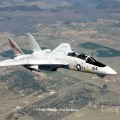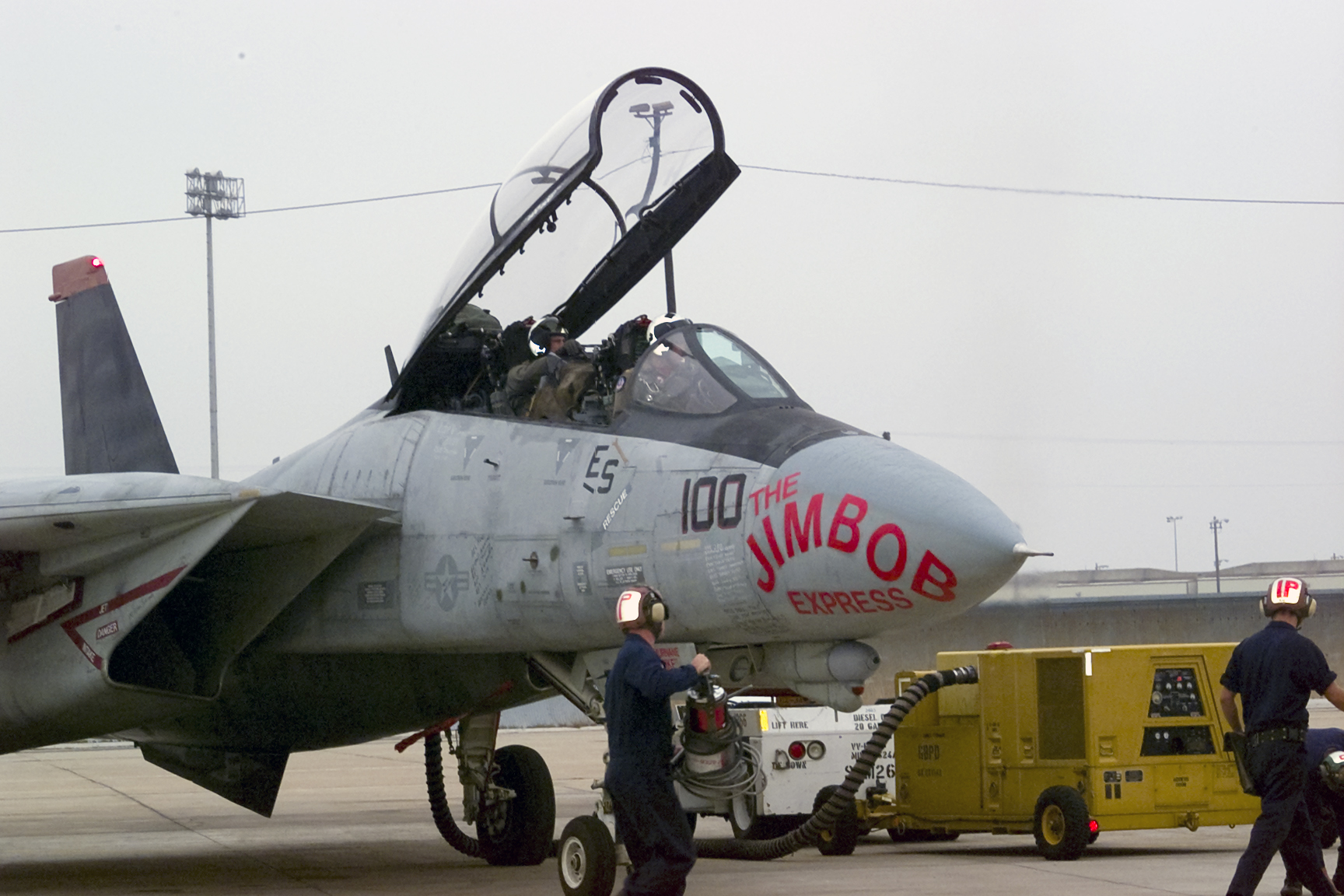-
Posts
1063 -
Joined
-
Last visited
Content Type
Profiles
Forums
Events
Everything posted by LanceCriminal86
-

F-14 A/B feature follow-up, wish list and beyond
LanceCriminal86 replied to scommander2's topic in DCS: F-14A & B
Definitely not happening. Not only because documentation, but it was immediately discontinued from use and started being removed from jets partway through the first F-14 cruise, and not mounted on any later jets. And the team has elsewhere expressed those early jets are well out of scope. -

"Official" F-4E Livery Discussion
LanceCriminal86 replied to LanceCriminal86's topic in DCS: F-4E Phantom
The HGU-55G is planned eventually with a more proper German pilot. -
They're just counterweights for TARPS pod. On cruise or during workups fleet squadrons would just use the Phoenix pylons, and it was eventually just how the remaining squadrons did it in the 90s. But during the 80s and early 90s you'd definitely see shore-based squadrons with the Sparrow slugs, I don't have copies that are web-hosted but I've got shots from VF-202, VF-124, etc. showing them. I don't believe they were even a wired-in CATM, but rather just a Sparrow body full of concrete from what some former maintainers said. VF-202 even stenciled 'Superheats' on theirs.
-
Because they didn't get the capability until 2002.
-

F-14B(?) Upgrade as featured in DCS 2025 video
LanceCriminal86 replied to VR Flight Guy in PJ Pants's topic in DCS: F-14A & B
Not fly-by-wire, it replaces the AFCS and works to curb a few undesired tendencies the Tomcat has at high AOA and low speed. But to some pilots it was like training wheels. It was mainly to prevent dangerous situations that would lead to flat spins. -
They have to rip into the cockpit art anyways to work on the earlier A stuff and the cleaner cockpits that they've hinted on. The F-14's cockpit wasn't put together the same way the F-4's was so it's more intrusive to go back in there and rework the cockpit to clean it up. And if you're already doing that, spending some extra art hours to get the B Upgrade bits modeled, some of which are also correct for the existing Late F-14A and B, then it makes a lot of sense to just get it all done at once.
-
In the past, we've overwritten cockpit files in a skin such as changing the BuNO plate on the F-14. It should work in the F-4 that way, so I'd try just dropping it in with the rest of the skin files.
-
You have to go under the Mods folder which contains the cockpit, not CoreMods. So from main DCS folder X:\DCS World OpenBeta\Mods\aircraft\F-4E , and under that Shapes will have the cockpit EDM, and Textures folders there has subfolders one of which has the VR body zip. If you load the cockpit edm you can generate a livery file that will include the VR body, the lines end with "highrez"
-
Open the cockpit in model viewer, use the "generate livery file", and cross reference with the textures themselves in the mods/f4e/textures/cockpit/vr_body.zip file. Basically look for the lines that end in highrez.
-
It being posted and screenshotted from discord did not mean it was originally posted in a *public* manner. Cobra did not leak/post it publicly, hence IronMike's explanation which was also posted.
-
He's around and fine.
-
They also don't play well with normal maps and roughmets in some situations, which makes them look like absolute crap when you have things like slime lights and panel lines running around those areas. The F-4E would definitely be impacted by that as the usual tail locations for base codes and serials are all around the slime lights.
-

F-14 Carrier Ops Campaign on Frozen Fjords in Kola
LanceCriminal86 replied to Horns's topic in DCS: F-14A & B
Teamwork and WEST WIND '88 was exactly this, Forrestal and Roosevelt operating with NATO in the Fjords. It's the cruise I did my Tomcat skins for the Forrestal release, and a set of '88 VF-41/84 should go perfectly as we have both carriers and now Kola. It would be a logical exercise to model, if not as a basis to make a "hot" scenario. -
Oh, this again. Cue that beautiful bean footage of a 54C from 1984 in an ACM shot definitely not being an un-agile bomber only missile at the 7:20 mark:
- 25 replies
-
- 10
-

-

Wish List: F-4E - Gueneau 316 Helmet
LanceCriminal86 replied to II.JG1_Vonrd's topic in DCS: F-4E Phantom
Unfortunately, a helmet existing in a separate 3rd party's module in no way makes it usable or accessible to HB as that mesh is part of the module's EDM. They'd have to get the mesh from the 3rd party and effectively go through the whole process of adding another helmet as they would any other, and they probably would start over anyways for it to be up to their standards. Until ED decouples pilots and their animations from the aircraft there's no easy way to support more pilot types, gear, helmets etc. short of the developer having to model them all in and hide/show them with animation arguments (which can start to be quite heavy on resources). It would be great if they ever do this, especially as many mods have not the greatest pilot bodies or they're way out of timeline for the aircraft. On the direct helmet topic, the 55G is the end of 80s - 90s+ onwards helmet and was already somewhat set upon as it can use the existing HGU-55 shell as a base. The extra bodies for Germany and Japan were a bonus/extra thing that came up because as I'm sure Cobra will admit, he saw photos and was like "cool, I want to do those". If anything else got added, personally the missing HGU-26 represents more of the USAF side as well as other export users, and the dual-visor setup is shared with the eventual Intruder and needs to be modeled for its HGU-43. After doing some digging of my own the Germans were definitely using the HGU-26 style by at least '83, it doesn't appear the Gueneau was the exclusive helmet necessarily. Definitely agree that it's fairly common especially the late 70s shots but even some of these early 80s ones I am seeing what look to be HGU-26 style, sometimes a mix of HGU and Gueneau. From '83, HGU-26 on the canopy: When the time comes for those other pilots to be done, it could be asked about I suppose but there's already resource crunches for all the art work needed not just for remaining Phantom items, but for the F-14, Viggen, AI Intruder, and other things that require the same set of resources to do. -

Wish List: F-4E - Gueneau 316 Helmet
LanceCriminal86 replied to II.JG1_Vonrd's topic in DCS: F-4E Phantom
German pilots with HGU-55G have been planned. Adding Guineau when we're missing other more USAF appropriate helmets seems not worth the effort. -
Not necessarily, it's appearing to be more of a latency issue. When the latency comes in online that exacerbates the problems with extrapolated tracks etc. That too is something there's been back and forth about but there just doesn't seem to be an easy solution. The AWG-9 is set up to simulate the cycle/track times and unfortunately network latency has a negative impact on it. So low latency, generally no impact. High latency, or one player with high latency, that's when the issues crop in but can't just be solved by adding a wider buffer in there for tracks as that wouldn't match how the radar operated. And yes, HB testers are submitting tracks and trying to get these issues run down but there's only so much that can be done on one side of the equation.
-
They're already aware of all that as well.
-
HB has no control over the missile once it leaves the jet. Yes, they've been trying to get ED to fix things but it's out of their direct control.
-

AGM-78 Standard ARM and Shrike B en DMAS varian?
LanceCriminal86 replied to Werewolf_fs's topic in DCS: F-4E Phantom
The AGM-78 was only used on modified Israeli F-4Es which are not the focus of the module, and of which there is currently no public data. Without proper evidence and documentation as to how the STARM was integrated, what panels were added/removed/modified, and how it was operated they're unlikely to add it. AGM-45B is waiting on ED to complete the weapon. -

3D model bug: F-14 rudders axis of rotation
LanceCriminal86 replied to bkthunder's topic in Bugs and Problems
Because you are changing how the graphics align between two different meshes. If you rotate the VStab forwards, then lines that would have gone straight across to the rudder will now be shifted upwards, and they will no longer line up. I again would rather have it fixed but I get why that's not a popular choice. With some of the other changes that need to happen on the jet and an actual earlier external model coming I'd bet the impact would be lessened by more folks coming back to migrate their skins to the earlier A or IRIAF externals. -

"Official" F-4E Livery Discussion
LanceCriminal86 replied to LanceCriminal86's topic in DCS: F-4E Phantom
Been building a list of the DMAS jets for when that time comes, that jet or another from 3TFW that were in Desert Storm are high on the list, and of course a number of the SJ jets, and the Spangdahelm jets. There were somewhere around 180 of the late jets upgraded with DMAS/ARN-101 but fewer wings and squadrons had those jets.


